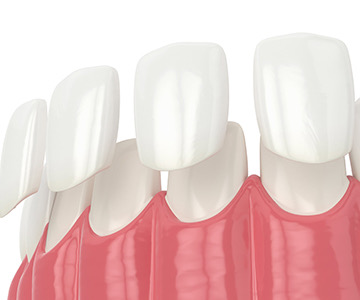Missing teeth are no longer a problem! Dental implants offer the most advanced, durable, and natural-looking solution for restoring your smile. An implant, together with its crown, mimics a real tooth both aesthetically and functionally-helping you regain confidence, comfort, and a complete smile.
To book a visit, sign up for a consultation. To clarify the details, our operator will contact you.

Prevention of tooth decay in children
12 September 2021
The human oral cavity contains a large number of microorganisms that spread very quickly. tooth decay is caused by microorganisms on the hard tissues of the tooth. The bacteria that live in the oral cavity are streptococci, lactobacilli, and actinomycetes. As a rule, they are "inherited" from the birth of the mother.
Usually, parents think that tooth decay on baby teeth is not so important, because babies will soon replace these teeth, but this is the wrong attitude. tooth decay of milk teeth is followed by infection of the soft and cool tissues around them, which can lead to various anomalies and complications, therefore tooth decay care for the child should begin during the pregnancy and under the constant supervision of the parents and the dentist.
Caring for baby teeth during pregnancy:
A parent should start caring for milk teeth in the antenatal period, that is, during pregnancy, because in the process of development of the embryo, the structure of the teeth is formed. Proper nutrition is very important during pregnancy, which means eating foods rich in calcium, magnesium, and other minerals. You must practice good oral hygiene, including brushing your teeth, flossing, and oral irrigating. It is important not only during pregnancy but also before the birth of a child, to carry out medical examinations to prevent tooth decay and other dental diseases.
Prevention of tooth decay in preschool children
Cases of tooth decay in preschool children are quite frequent since one of the main causes of tooth decay is sucrose, which is contained in refined sugar and in any sugar-containing product. To this must be added improper oral hygiene. It should also be noted that tooth decay progresses especially rapidly at this age.
After the eruption of milk teeth, the baby may develop "bottle tooth decay" - it occurs as a result of non-observance of hygiene rules. Breast milk has a big amount of sugar. If the bottle and pacifier are not cleaned properly or left in the newborn's mouth overnight, bacteria will spread rapidly, leading to tooth decay on the first temporary teeth. To prevent this from happening, it is necessary to clean the baby's gums and teeth with special gauze. Even for a one-year-old child, you can buy a soft toothbrush. We should start using toothpaste in about 1.5-2 years. The baby should be examined by a dentist every 3-4 months. With these steps, you can prevent the development of tooth decay or detect it at an early stage.
Prevention of tooth decay in school children
The prevention of tooth decay in school-age children is aimed at strengthening the enamel. For this, fissures are hermetically closed in children - a natural deepening of the chewing surface of the teeth.
Dental sealants are a special formulation containing minerals, mainly fluoride. The doctor cleans the enamel of the milk tooth from plaque, carries out antibacterial treatment, seals the sealant, and removes the remains of the substance with a drill. The procedure takes 10-30 minutes.
Secondary prevention includes treatment of early, first, or second stage carious lesions, when tooth decay has not yet reached dentin. Treatment is carried out by remineralizing the enamel. The procedure is about the same as filling. At this stage, a visit to the dentist is required twice a year to detect the disease. The child has been prescribed fluoride toothpaste for children.
Diet is critical in preventing tooth decay. Sweets should be limited, and after eating, rinse your mouth with water or brush your teeth so that no food debris remains.
Fissure sealing and its effectiveness in children
There are many grooves and dents on new teeth, so it is impossible to completely clean them from food waste and tooth decay appear. As soon as permanent teeth appear, it is advisable to cover them with a mass of a special thin consistency that fills the fissures to the full depth and prevents the accumulation of bacteria. As a result, it protects the oral cavity from the development of tooth decay.
A prerequisite before sealing fissures is that tooth decay should not be at the bottom of the cavity, as at this time an infection may develop under the sealant. It is recommended to start filling fissures at the age of 2.5-3 years when the teeth finally erupt. The first permanent teeth appear at the age of 5-6 years and this process continues until the age of 14.
Studies show that fissure sealing reduces the risk of tooth decay by 90%, although it is necessary to strictly follow the rules of oral hygiene on the part of the child.
During pregnancy, hormonal changes can cause gum inflammation, bleeding, enamel erosion, and an increased risk of cavities. That’s why visiting the dentist during pregnancy is especially important.
Gnathology is one of the leading branches of 21st-century dentistry. It forms the foundation for any complex dental treatment planning
Tooth loss (edentulism) affects not only the appearance of your smile but also the overall functional health of your oral cavity
Dental veneers can be made from various materials, but ceramic (porcelain) veneers are the most widely used.
Modern aesthetic and functional dentistry is continually evolving, striving to identify restorative materials that combine exceptional strength
The eruption of baby teeth is one of the most important stages in a child’s early development.
Modern dentistry increasingly emphasizes the importance of orthodontic care.
Oral health care begins long before the first permanent tooth erupts.
A smile is one of the key elements of a person’s visual identity. It conveys confidence and positivity. However, the beauty of a smile is not only an aesthetic factor—it is directly connected to oral health.
Orthodontic treatment has long gone beyond the limits of traditional metal braces.
Dental implantation is the best method for restoring missing teeth. However, for the procedure to be successful, the jawbone must have sufficient volume and density.
Dental implantation is one of the most effective and safest surgical procedures in modern dentistry for restoring missing teeth.
Initial endodontic (root canal) treatment is usually successful and helps preserve the natural tooth.
Root canal treatment, also known as endodontic therapy, is one of the most frequently discussed yet often misunderstood dental procedures.
Tooth decay is one of the most common dental conditions, involving damage to the hard tissues of the teeth
Modern dentistry is constantly evolving, offering improved methods for solving complex issues.
Today, there are numerous teeth whitening options—both at home and professionally done.
Modern dental clinics are equipped with special equipment that ensures the safe use of anesthesia.
















.jpeg)

.jpeg)
